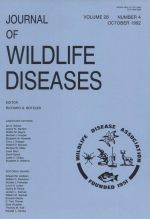Carcasses of day-old chicks were placed randomly in grazed, mixed-grass pasture at a density of 50/ha each day for 5 days. Randomly chosen circular plots with a combined area equal to 10% of the total were searched each day for 10 days. The search method detected 95.2% of carcasses placed the day of the search but remains were found of only 20.8% of chicks placed 24 hr prior to searches. Seventy-six percent of carcasses that were observed daily disappeared completely within 24 hr. Although 250 carcasses were placed over a 5-day period, only two intact carcasses that had been in place for ≥24 hr were found during searches. Estimates derived by extrapolation from the sampled area underestimated cumulative “mortality” on the entire area and did not reflect the course of the simulated outbreak well. There was a low degree of precision among repeated samples from the same area.
How to translate text using browser tools
1 October 1992
CARCASS DISAPPEARANCE AND ESTIMATION OF MORTALITY IN A SIMULATED DIE-OFF OF SMALL BIRDS
G. Wobeser,
A. G. Wobeser

Journal of Wildlife Diseases
Vol. 28 • No. 4
October 1992
Vol. 28 • No. 4
October 1992
epizootic
estimation
investigation
mortality
sampling
scavenging




